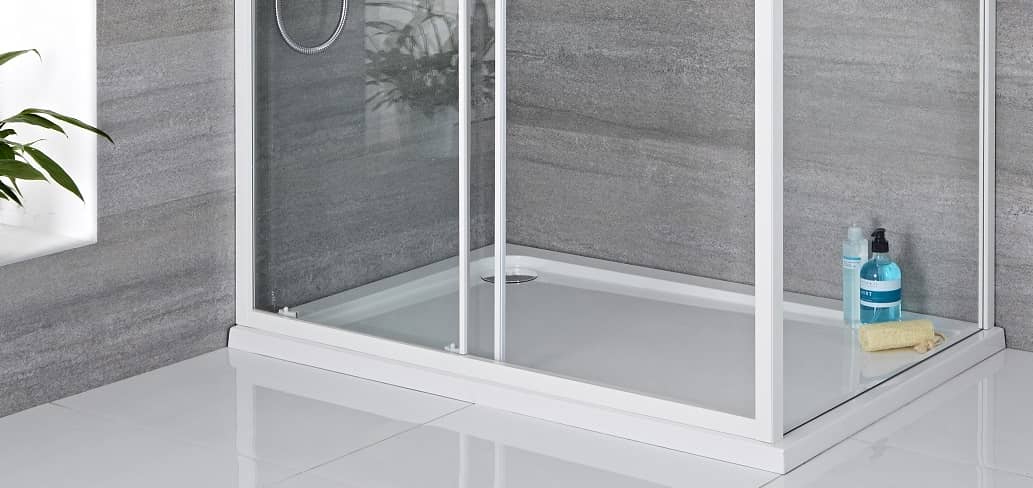Silicone Sealant Bathroom Shower
In this easy to follow step-by-step guide we explain how to seal a shower tray the right way to ensure you achieve a professional result. You'll also find out how to remove the old sealant and prepare the area ready for the new silicone sealant. Replacing the sealant around your shower tray provides a simple yet effective way to freshen up the look of your bathroom.

Removing the old silicone sealant
The best way to remove old silicone sealant is with a sharp knife, chisel or Stanley knife (make sure to wear thick safety gloves for this), and gently slice away the sealant as much as you can. Take care when doing this to avoid scratching or damaging the surface.
Once you've removed most of the sealant from the surface you'll be left with at least some small strands. Use either your finger or thumb to rub it off or you can use white spirit – simply dab a little on an old cloth and rub over the excess strands until they come off or dissolve.
Preparation is the most important part of applying silicone sealant, follow these top tips to ensure the best possible results.
- Before using silicone sealant always read the manufacturer's instructions. The sealant must be fully cured before it comes into contact with water.
- Remove any dust and loose deposits with a vacuum cleaner, and then clean the shower tray surface and tiles with a damp cloth that's been soaked in warm water and mild detergent.
- Once clean, remove any detergent with a damp cloth and then wipe the area dry with a paper towel.
- If any moisture remains, the silicone sealant may not fully adhere to the surface, so leave the shower tray to dry for a couple of hours before applying the sealant.
Sealing a shower tray
Tools you'll need:
- High quality silicone sealant– make sure it's designed for bathroom use and that it contains an anti-fungal additive.
- Use the right type of sealant – if you've used natural stone for the floor and wall coverings you'll need to select a sealant that's compatible with this type of material.
- Sealant application gun– this allows you to apply the sealant evenly and achieve a consistent bead.
- Silicone sealant application tool– designed to remove excess sealant.
- Paper towels – when smoothing the sealant you'll need to clean the excess with a paper towel.
1. Ensure the area is dry
Ensure the shower tray and walls are completely dry, and free from dirt and dust.
2. Select the correct aperture size
If using a tool to smooth the sealant, select the correct aperture size so that the finished bead completely covers the gap between the tiles and tray.
3. Cut the application nozzle
Cut the application nozzle on the sealant tube at a 45 degree angle, ensure the hole is not too big. The nozzle will have marks indicating where and how to trim the nozzle. A 5mm hole is typical for the majority of applications, but it can be enlarged if a wider bead is needed.
4. Apply an even bead of silicone sealant
Start in the inner corner of the shower tray, apply gentle pressure to the trigger of the application gun and work towards the front of the tray in one continuous movement. Ensure that an even bead of silicone is applied. Do not apply too much as it will be tricky to remove.
5. Make sure there are no visible gaps
The bead of silicone sealant should be thick enough so it covers the gap between the tray and tiles. Make sure there are no visible gaps, if there are any, carefully add a little more sealant to the area.
6. Wipe the excess away
Once you've completed each line of sealant, release the pressure from the application gun or it will continue to flow from the nozzle. Wipe the excess away and replace the cap.
7. Smooth out the sealant
Place the smoothing tool against the tray and tiles, start from the point where you first applied the sealant and apply gentle yet consistent pressure pulling the tool along the length of the tray to remove excess sealant leaving an even bead.
When you've created a smooth bead do not keep smoothing the sealant as it will tear, become untidy and may not adhere correctly.
8. Leave to fully dry
The fresh silicone sealant should be left to dry for a minimum of 24 hours.
Fit a shower tray, grout tiles, tile a shower wall, install a shower enclosure…

Hi, I'm Liz, an interiors blogger. My main focus area is the bathroom, where I aim to inspire anyone who's planning and designing a new bathroom – you'll find plenty of tips, how-to guides and a wealth of ideas!
Silicone Sealant Bathroom Shower
Source: https://www.bigbathroomshop.co.uk/info/blog/how-to-seal-a-shower-tray-the-right-way/



0 Komentar